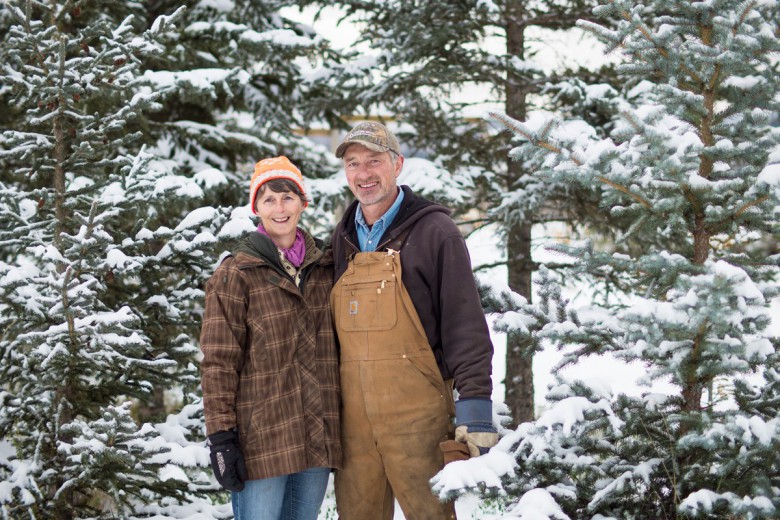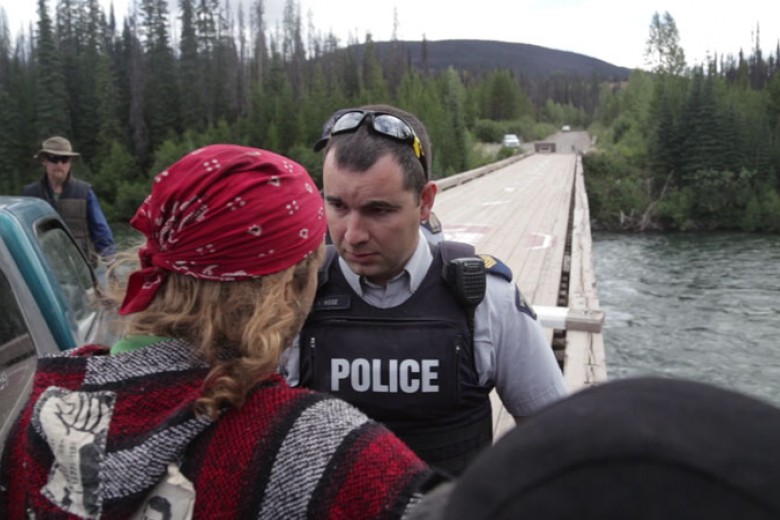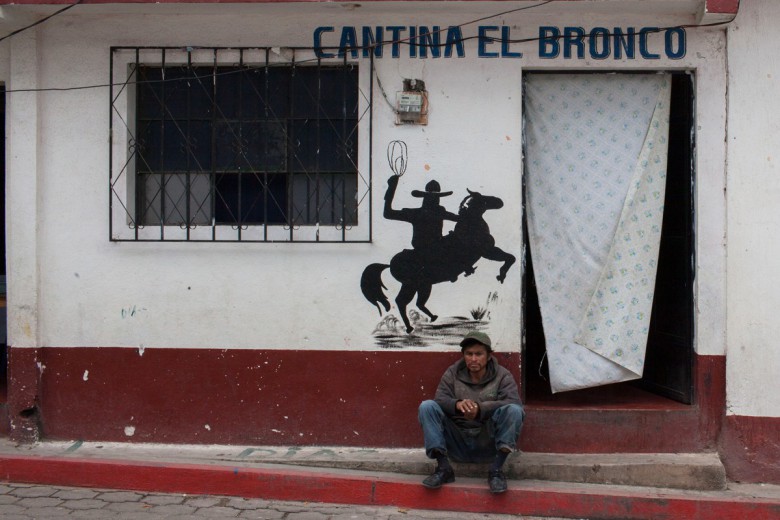_1000_665_90.jpg)
Lines etch across Tomasa Perez Jimenez’s tawny features as her eyes study her floor. The cracked earth contrasts with the party pink of her traditional blouse. Her voice is quiet and steady as she discusses the mine that has been operating on her doorstep for more than a decade.
“In truth, [the mine] has brought a lot of conflict here; it’s brought very many social and environmental conflicts,” says the 54-year-old subsistence farmer.
Jimenez is a Maya-Mam from Tuixcajchis, a village of 1,500 people in the municipality of Comitancillo, which ascends to an elevation of 2,650 metres in the department of San Marcos in northwestern Guatemala.
The Maya-Mam farmers of northwestern Guatemala are descendants of the Maya civilization that flourished from 2000 BC to AD 900. For 2,000 years they have been planting and harvesting indigenous maize, beans, and squash on small plots of land scattered along the sides of the arid Sierra Madre de Chiapas mountains.
Violent colonization and occupation of their land, labour, and resources are nothing new to the Maya-Mam – they have endured it for nearly half a millennium. During successive conquests of Spanish conquistadores and then German landowners, invaders seized the most fertile lands for plantations and forced the men to cut coffee and build roads.
From the 1960s to the 1990s, the Guatemalan government, which has never in more than a century of existence had an Indigenous leader, violently targeted the Maya-Mam and other Indigenous ethnic groups in northwestern Guatemala with acts of genocide. A scorched earth counter-insurgency policy was enacted in the early 1980s, in which villages were razed, women were raped, and men were burned alive inside churches. The four-decade assault on Indigenous peoples during the civil war claimed 200,000 lives.
Today, the international resource extraction industry is the primary force appropriating the ancestral lands of Maya-Mam farmers. Goldcorp is a Vancouver-based corporation that ranks as one of the largest mining companies in the world and has, according to the local population, illegally extracted over 1 million ounces of gold from the Marlin Mine using open-pit technology.
In 2005, Maya-Mam farmers were informed by corporate and government officials that the land in San Marcos had been sold to a company for producing orchids, says Francisco Mauricio, a 40–year-old agricultural technician working with the Maya-Mam Association for Research and Development (AMMID). AMMID is a local organization that supports farmers and women’s groups to build household and community capacity.
“After the land was sold, people began to watch the arrival of heavy-duty machinery. Machine after machine [came], and suddenly the people said, ‘What’s going on here? What kind of orchids are they producing with this machinery?’” says Mauricio.
“People never knew it was going to be a mine. They were tricked; they were fooled,” he says. “The mine has deceived many people here in order to develop.” The Guatemala Human Rights Commission has published other testimonies that corroborate Mauricio’s claims.
_1000_666_90.jpg)
The development of the Marlin Mine is backed by major internal and external stakeholders, including the World Bank’s International Finance Corporation, which lent US$45 million in start-up capital to Glamis Gold, the Canadian-registered company that launched the project before selling the contract to Goldcorp in late 2005.
There was an immediate move to action by the Maya-Mam and other Indigenous groups, such as the Sipakapense, in 2004 when they began to organize and protest against the mine. The national government, in response, deployed military forces to quell the people’s resistance. Equipped with riot gear, water cannons, rubber bullets, and guns, state forces were sent to chase away crowds of farmers and community members while protecting the company’s site and equipment. Undeterred, the Maya-Mam organized consultations and referendums to discuss the benefits and consequences of the mining activity in their communities and to vote on the issue.
“All of the communities [in San Marcos] have said no to the mine, but the government doesn’t recognize the consultations as binding,” says Mauricio.
Maya-Mam communities and organizations have sought international support, appealing to human rights groups and arguing that the government and Goldcorp have broken International Labour Organization Convention No. 169 on Indigenous and Tribal Peoples, which ensures Indigenous peoples’ rights to free and informed consent to land use.
Rights Action, a Canadian advocacy organization, and the Pastoral Commission for Peace and Ecology have documented cases of poor health and of environmental degradation, including high levels of cyanide, arsenic, aluminum, and nitrates – chemicals used in the open-pit extraction technology – in the rivers and waterways of communities living downstream from the Marlin Mine.
In August 2012, via the Peoples’ International Health Tribunal, the community reported cases of skin irritations and respiratory infections among infants and children living in communities surrounding the mine, leaving farmers to wonder if there’s a connection between contaminated groundwater and waterways and the illnesses.
Farmers also fear that acid rain, produced by evaporation of contaminated water into the atmosphere, is the cause of decreased fruit tree and crop yields.
“The mine uses water to wash [minerals] that they remove from the mountain,” explains Victoria Aguilón, a 50-year-old farmer from the nearby village of Taltimiche. “The contaminated water goes into the rivers and eventually the sea, and it comes back when it rains, destroying the leaves. Maybe it’s why the trees don’t give fruit anymore. It’s damaging everything. That’s what the people are saying.”
While Aguilón and many others can’t be certain the mine is at fault for the current crisis, they say that having a mine in their communities or not should be their choice.
In a dry climate, Aguilón and other farmers are also protesting the depletion of essential groundwater resources by gold mining operations, which can consume up to 250,000 litres of water per hour. Goldcorp enjoys access to the local water supply for its operations without paying state utilities for the privilege.
In 2010, the Inter-American Commission on Human Rights ordered the Guatemalan government and Goldcorp to provide the affected communities with sufficient, safe drinking water, but both institutions deny the mines have any negative impact on health or the environment and have ignored the commission’s order. Instead, despite 10 years of local and international protest and resistance, Goldcorp continues to explore underground mineral veins that feed into the Marlin Mine’s reserves.
_1000_666_90.jpg)
Goldcorp is also expanding its operations to the Chocoyos site, which rests on top of the Delmy vein that runs from the Marlin Mine and holds vast reserves of silver. The Chocoyos site is 10 kilometres from the home of Jimenez and her neighbours in Tuixcajchis. They fear for their land and their livelihoods, anticipating knocks on their wooden doors and adobe walls by mining officials who will pressure them to sell their property.
“If one day the company comes to my home, my garden, I won’t sell my land,” says Maria Valentina, a 54-year-old widow from Tuixcajchis. “I won’t sell because I need to survive. If I sell, where am I going to live?”
AMMID is discouraging farmers from selling their land. “The company pays well for the land,” explains Erwin Orozco, an agricultural technician with AMMID, “but the problem is that if a farmer sells their five hectares of land that they have here and they move elsewhere (closer to town) in the municipality to buy land, the money isn’t enough. They will only get, maybe, half a hectare of land, which isn’t enough to live off.”
Goldcorp says it is dedicated to development and that it sends officials to consult with community leaders about development projects, including the construction of roads, health clinics, and schools. The Fundación Sierra Madre, a non-profit organization financed by Goldcorp, reports to have funded over 100 social and health infrastructure projects. In a 2010 report, Goldcorp wrote, “[We are] confident that the Marlin Mine has had a positive impact on social and economic development.”
Whether the benefits outweigh the harm is a matter of major contention between the Maya-Mam, Guatemalans, and foreign investors, but there is no question some communities reject the presence of Goldcorp and other mining firms.
“Even though the communities are saying no,” says Orozco, “the company officials make a strong impact to [try to] convince people to allow the mine into their community.”
For many farmers in Tuixcajchis, including Aguilón, the short-term benefits of health clinics and roads do not outweigh the long-term negative impact of environmental degradation, particularly the contamination and consumption of water resources.
“We are saying, leave our territory because it doesn’t belong to them,” exclaims Aguilón. “God created it for the Maya people. They have their own land, their own houses [in Canada], so they should leave us in peace. That’s what we want here.”
But what Aguilón doesn’t realize is that Goldcorp’s relation to the Maya-Mam and other Indigenous groups in northwestern Guatemala simply mirrors how the Canadian extractive industry operates on Canadian soils, appropriating Indigenous lands, buying off leaders, and destroying traditional ways of life while poisoning communities.
The future of the Maya-Mam’s traditional lands in Guatemala remains uncertain. Two Canadian groups, Rights Action and the Council of Canadians, are urging Canadians to write letters to Goldcorp and the Canadian government to demand that the company remove itself from the Marlin Mine and Chocoyos sites in San Marcos.






